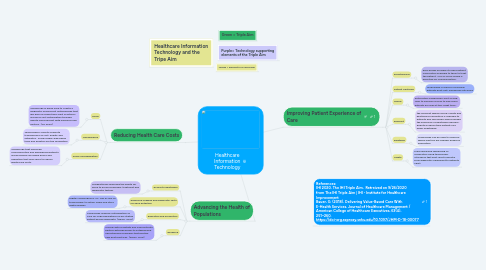
1. Advancing the Health of Populations
1.1. Access to healthcare
1.1.1. Telehealth has improved the ability for some to access providers, treatment and diagnostic testing.
1.2. Advanced Imaging and Diagnostic Tests for early detection
1.2.1. Digital Mammograms, CT, MRI all rely on technologoy to obtain, share and store digital images.
1.3. Education and Prevention
1.3.1. Technology enables customization of care for large populations as we stratify patient group using data. (Bauer. 2018).
1.4. Research
1.4.1. Clinical data scientists and informaticists partner with physicians to establish and operationalize programs that identify new best practices. (Bauer. 2018)
2. Reducing Health Care Costs
2.1. DATA
2.1.1. Technology is being used to Create a diagnostic assessment methodology that will help us understand "best Practices" and drive cost optimization through quality improvement with measures and metrics. (IHI 2020)
2.2. Transparency
2.2.1. Technology is used to promote transparency of cost, quality and estimates. Social media, web based tools and anaytics are the foundation.
2.3. Policy and Regulation
2.3.1. Technology that improved communication and empowered patients and providers can shape policy and regulation that may serve to reduce health care costs.
3. Healthcare Information Technology and the Tripe Aim
4. Green = Triple Aim
5. Yellow = Elements of Triple Aim
6. Purple= Technology supporting elements of the Triple Aim
7. Improving Patient Experience of Care
7.1. Effectiveness
7.1.1. EHR Allows Providers to have patient information available to them to treat the patient. Use of Social Media is effective for communication.
7.2. Patient Centered
7.2.1. Technology is used for surveying patients post visit, measuring outcomes
7.3. Timely
7.3.1. Automated scheduling is part of EHR. Help to measure access to mak esure patients are seen at the "right time".
7.4. Efficient
7.4.1. the Speed at which record, results and healthcare information is available to patients and care givers has increased the efficiency of healthcare delivery. Robotics reduce time patients are under anesthesia.
7.5. Equitable
7.5.1. Technology can be used to measure where Doctors are needed, based on population.
7.6. Safety
7.6.1. Prescribing and dispensing of medication using technology. Interfaces that post results directly from diagnostic equipment to patients chart.
